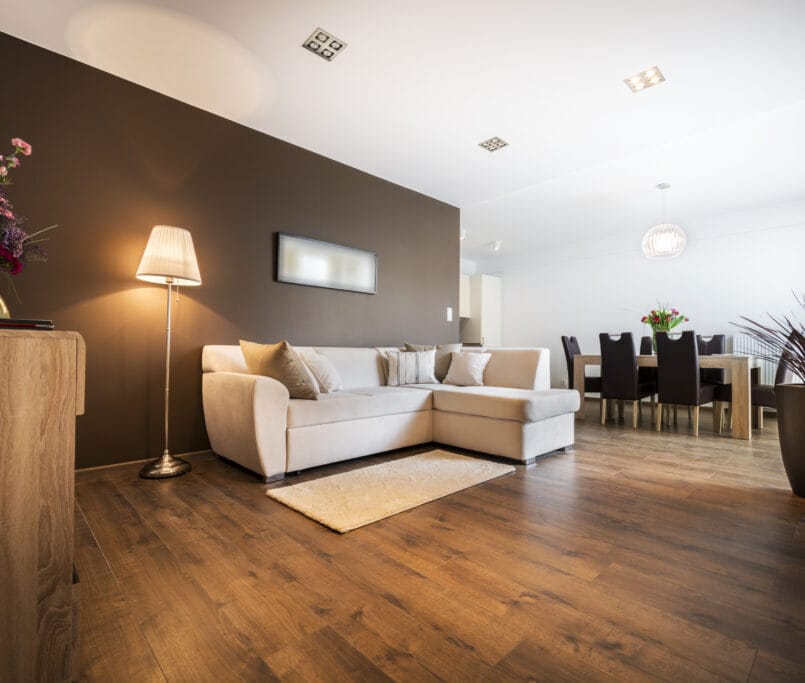When is the Best Time of Year to Install Hardwood Floors?
When it comes to installing hardwood flooring, timing is everything. At Dura Flooring in Commerce, CA, we understand that choosing the right time of year for hardwood installation can make a significant difference in the outcome of your flooring project. Here, we’ll explore the best times to install hardwood floors, considering factors like humidity levels, the installation process, and seasonal conditions.
Understanding the Impact of Humidity Levels
Humidity levels play a crucial role in the success of a hardwood flooring installation. Wood is a natural material that expands and contracts with changes in moisture content. High humidity can cause hardwood to swell, while low humidity can make it shrink. This natural movement can lead to gaps, warping, and other issues if not properly managed during the installation process.
In Commerce, CA, where the climate is relatively dry, maintaining stable humidity levels is essential. The ideal range for hardwood flooring is between 35% and 55%. Installing during periods of stable humidity can help ensure that your hardwood floors remain in excellent condition for years to come.
The Best Time of Year for Hardwood Installation
Spring and Fall: Ideal Conditions
Spring and fall are often considered the best times of year to install hardwood floors. During these seasons, humidity levels are typically more moderate, reducing the risk of wood expanding or contracting excessively. The temperatures are also more comfortable for both the installers and the curing process of adhesives and finishes.
In spring, the weather starts to warm up, but it’s not yet the hot, dry summer. This transitional period allows for a more controlled environment for flooring installation. Similarly, fall offers a cooling climate after the heat of summer, providing another excellent opportunity for hardwood installation.
Summer: Proceed with Caution
Summer can be a tricky time to install hardwood floors, especially in regions like Commerce, CA, where temperatures can soar. High temperatures combined with low humidity can cause hardwood to dry out and shrink, potentially leading to gaps and other issues post-installation. However, with proper climate control inside your home, such as using air conditioning and humidifiers, summer installations can still be successful.
Winter: A Challenging Season
Winter presents its own set of challenges for hardwood installation. The cold weather and lower humidity levels can make wood more brittle and prone to cracking. Additionally, heating systems can dry out the air indoors, further reducing humidity levels. If you must install hardwood floors in winter, it’s crucial to use humidifiers to maintain optimal moisture levels in your home.
Preparing for the Installation Process
Regardless of the time of year you choose, proper preparation is key to a successful hardwood flooring installation. Here are some steps to ensure a smooth process:
Acclimation
Acclimating the hardwood to your home’s environment is a critical step. This involves letting the wood sit in the room where it will be installed for at least a few days before installation. This helps the wood adjust to the room’s temperature and humidity, reducing the risk of future movement.
Subfloor Preparation
Ensuring that the subfloor is clean, dry, and level is essential for a successful installation. Any moisture issues in the subfloor should be addressed beforehand to prevent future problems with the hardwood floors.
Professional Installation
While DIY projects can be tempting, hardwood installation is best left to professionals. Experienced installers have the knowledge and tools to handle the nuances of hardwood flooring, ensuring a flawless result.
Additional Considerations
Home Renovations
If you’re planning other home renovations, it’s wise to schedule your hardwood installation after major construction work is completed. This prevents damage to the new floors and ensures that any changes in the home’s structure won’t affect the hardwood.
Budget and Availability
Consider your budget and the availability of materials and installers when planning your project. Some times of the year may have higher demand, which can affect prices and scheduling. Planning ahead can help you avoid these issues.
Long-Term Maintenance
Think about the long-term maintenance of your hardwood floors. Different seasons can affect how you care for your floors. For example, summer may require more frequent cleaning to handle dust and dirt, while winter may involve using humidifiers to maintain proper moisture levels.
Choosing the best time of year to install hardwood floors involves considering various factors, including humidity levels, the installation process, and seasonal conditions. At Dura Flooring in Commerce, CA, we recommend spring and fall as the ideal times for hardwood installation due to their moderate climates. However, with proper preparation and climate control, successful installations can be achieved year-round.
If you’re ready to transform your home with beautiful hardwood floors, our team at Dura Flooring is here to help. Contact us today to schedule a consultation and take the first step towards your dream flooring.






